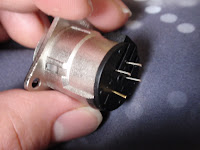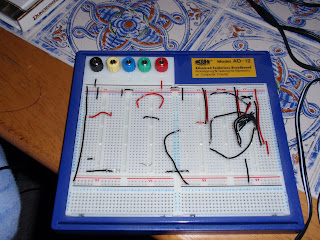There's not much I can really say, other than posting the code, which doesn't quite feel like the place here to post, however I may as well post it, although the formatting may be a bit out where tabs are just transferred as spaces.
So anyway, the Macro Include file, (I put Macro's into a different include file):
;***********************************************************************And the main application file:
; Filename: LED_Segment.inc
; Date: 28th February 2011
; Author: M.J.Andrews
; Purpose: Program to contain macro's for the LED Segment program.
;***********************************************************************
;***********************************************************************
;**** M A C R O ' S ****
;***********************************************************************
; ----------------------------------------------------------------------
; Macro : TOGGLE_STATUS_LED
; Purpose : Macro to toggle the processing LED. This is kept flashing
; while we run the program as it shows that the processor is
; working correctly and make it obvious if the code gets stuck.
; ----------------------------------------------------------------------
TOGGLE_STATUS_LED MACRO
btg LATA, RA0 ; Toggle the LED status
ENDM
; ----------------------------------------------------------------------
; Macro : SET_LATC
; Purpose : Macro to set the value of the LATC byte which is most of the
; 7-segment display entries. We also toggle the status LED so
; that we can see the LED flash to show the processor running.
; ----------------------------------------------------------------------
SET_LATC MACRO LATCValue
TOGGLE_STATUS_LED
MOVLW LATCValue
MOVWF LATC
ENDM
; ----------------------------------------------------------------------
; Macro : SET_SEGMENT_TO_0
; Purpose : Set the LED 7-Segment display to "0"
; ----------------------------------------------------------------------
SET_SEGMENT_TO_0 MACRO
SET_LATC 0x80
bcf LATB, 0
bcf LATB, 1
ENDM
; ----------------------------------------------------------------------
; Macro : SET_SEGMENT_TO_1
; Purpose : Set the LED 7-Segment display to "1"
; ----------------------------------------------------------------------
SET_SEGMENT_TO_1 MACRO
SET_LATC 0xFB
bcf LATB, 0
bsf LATB, 1
ENDM
; ----------------------------------------------------------------------
; Macro : SET_SEGMENT_TO_2
; Purpose : Set the LED 7-Segment display to "2"
; ----------------------------------------------------------------------
SET_SEGMENT_TO_2 MACRO
SET_LATC 0x44
bcf LATB, 0
bcf LATB, 1
ENDM
; ----------------------------------------------------------------------
; Macro : SET_SEGMENT_TO_3
; Purpose : Set the LED 7-Segment display to "3"
; ----------------------------------------------------------------------
SET_SEGMENT_TO_3 MACRO
SET_LATC 0x41
bcf LATB, 0
bcf LATB, 1
ENDM
; ----------------------------------------------------------------------
; Macro : SET_SEGMENT_TO_4
; Purpose : Set the LED 7-Segment display to "4"
; ----------------------------------------------------------------------
SET_SEGMENT_TO_4 MACRO
SET_LATC 0x03
bcf LATB, 0
bsf LATB, 1
ENDM
; ----------------------------------------------------------------------
; Macro : SET_SEGMENT_TO_5
; Purpose : Set the LED 7-Segment display to "5"
; ----------------------------------------------------------------------
SET_SEGMENT_TO_5 MACRO
SET_LATC 0x01
bsf LATB, 0
bcf LATB, 1
ENDM
; ----------------------------------------------------------------------
; Macro : SET_SEGMENT_TO_6
; Purpose : Set the LED 7-Segment display to "6"
; ----------------------------------------------------------------------
SET_SEGMENT_TO_6 MACRO
SET_LATC 0x00
bsf LATB, 0
bcf LATB, 1
ENDM
; ----------------------------------------------------------------------
; Macro : SET_SEGMENT_TO_7
; Purpose : Set the LED 7-Segment display to "7"
; ----------------------------------------------------------------------
SET_SEGMENT_TO_7 MACRO
SET_LATC 0xFB
bcf LATB, 0
bcf LATB, 1
ENDM
; ----------------------------------------------------------------------
; Macro : SET_SEGMENT_TO_8
; Purpose : Set the LED 7-Segment display to "8"
; ----------------------------------------------------------------------
SET_SEGMENT_TO_8 MACRO
SET_LATC 0x00
bcf LATB, 0
bcf LATB, 1
ENDM
; ----------------------------------------------------------------------
; Macro : SET_SEGMENT_TO_9
; Purpose : Set the LED 7-Segment display to "9"
; ----------------------------------------------------------------------
SET_SEGMENT_TO_9 MACRO
SET_LATC 0x01
bcf LATB, 0
bcf LATB, 1
ENDM
; ----------------------------------------------------------------------
; Macro : SET_SEGMENT_TO_A
; Purpose : Set the LED 7-Segment display to "A"
; ----------------------------------------------------------------------
SET_SEGMENT_TO_A MACRO
SET_LATC 0x02
bcf LATB, 0
bcf LATB, 1
ENDM
; ----------------------------------------------------------------------
; Macro : SET_SEGMENT_TO_B
; Purpose : Set the LED 7-Segment display to "b"
; ----------------------------------------------------------------------
SET_SEGMENT_TO_B MACRO
SET_LATC 0x00
bsf LATB, 0
bsf LATB, 1
ENDM
; ----------------------------------------------------------------------
; Macro : SET_SEGMENT_TO_C
; Purpose : Set the LED 7-Segment display to "C"
; ----------------------------------------------------------------------
SET_SEGMENT_TO_C MACRO
SET_LATC 0x8C
bsf LATB, 0
bcf LATB, 1
ENDM
; ----------------------------------------------------------------------
; Macro : SET_SEGMENT_TO_D
; Purpose : Set the LED 7-Segment display to "d"
; ----------------------------------------------------------------------
SET_SEGMENT_TO_D MACRO
SET_LATC 0x40
bcf LATB, 0
bsf LATB, 1
ENDM
; ----------------------------------------------------------------------
; Macro : SET_SEGMENT_TO_E
; Purpose : Set the LED 7-Segment display to "E"
; ----------------------------------------------------------------------
SET_SEGMENT_TO_E MACRO
SET_LATC 0x04
bsf LATB, 0
bcf LATB, 1
ENDM
; ----------------------------------------------------------------------
; Macro : SET_SEGMENT_TO_F
; Purpose : Set the LED 7-Segment display to "F"
; ----------------------------------------------------------------------
SET_SEGMENT_TO_F MACRO
SET_LATC 0x06
bsf LATB, 0
bcf LATB, 1
ENDM
; ----------------------------------------------------------------------
; Macro : SET_SEGMENT_TO_CLEAR
; Purpose : Set the LED 7-Segment display to blank with no LED's lit
; ----------------------------------------------------------------------
SET_SEGMENT_TO_CLEAR MACRO
SET_LATC 0xFF
bsf LATB, 0
bsf LATB, 1
ENDM
;******************************************************************************
; Filename: LED Segment.asm *
; Date: 28th February 2011 *
; Author: M.J.Andrews *
;******************************************************************************
LIST P=18F2455, F=INHX32 ; Directive to define processor
#include <P18F2455.INC> ; Processor specific variable definitions
#include <LED_Segment.INC> ; Macro's for use with this program
;******************************************************************************
; Configuration bits
CONFIG FOSC = INTOSC_HS ;HS - HS OSCILLATOR
;******************************************************************************
; Variable definitions
UDATA
WREG_TEMP RES 1 ; Variable in RAM for context saving
STATUS_TEMP RES 1 ; Variable in RAM for context saving
BSR_TEMP RES 1 ; Variable in RAM for context saving
UDATA_ACS
CNT_INNER RES 1 ; Delay procedure, Inner Loop Count
CNT_OUTER RES 1 ; Delay procedure, Outer Loop Count
LED_SEGMENT_DISP RES 1 ; LED Segment counter variable
;******************************************************************************
; EEPROM data
DATA_EEPROM CODE 0xf00000
DE "Test Data",0,1,2,3,4,5
;******************************************************************************
; Reset vector's
RESET_VECTOR CODE 0x0000
goto Main ; Go to start of main code
HI_INT_VECTOR CODE 0x0008
bra HighInt ; Go to high priority interrupt routine
LOW_INT_VECTOR CODE 0x0018
bra LowInt ; Go to low priority interrupt routine
;******************************************************************************
;**** Start of the Program Code Section ****
;******************************************************************************
CODE
;******************************************************************************
; High priority interrupt routine
;******************************************************************************
HighInt:
retfie FAST
;******************************************************************************
; Low priority interrupt routine
;******************************************************************************
LowInt:
movff STATUS,STATUS_TEMP ;save STATUS register
movff WREG,WREG_TEMP ;save working register
movff BSR,BSR_TEMP ;save BSR register
; *** low priority interrupt code goes here ***
movff BSR_TEMP,BSR ;restore BSR register
movff WREG_TEMP,WREG ;restore working register
movff STATUS_TEMP,STATUS ;restore STATUS register
retfie
;******************************************************************************
;**** M A I N C O D E ****
;******************************************************************************
Main:
Initialize
bcf TRISA, TRISA0 ; RA0 as an output for the "working" led
bcf TRISB, TRISB0 ; RB0 as an output for the 7-segment LED
bcf TRISB, TRISB1 ; RB1 as an output for the 7-segment LED
clrf WREG ; Clear the Working Register
movwf TRISC ; W-REG to PORTC to set as all outputs
movlw 0x00 ; Start with 0 in the Working Register
movwf LED_SEGMENT_DISP ; Move the 0 to the Segment counter
Start_Loop
movff LED_SEGMENT_DISP, WREG ; Copy the value of the counter to W-REG
call DisplaySegments ; Call proc to display LED value in W-REG
call Delay ; Call the delay procedure so we see value
incf LED_SEGMENT_DISP ; Increment the LED counter
goto Start_Loop ; Go back to the start of the loop
;******************************************************************************
;**** P R O C E D U R E S ****
;******************************************************************************
; ----------------------------------------------------------------------
; Function: DisplaySegments
; Purpose : Procedure which can be called to display the low 4-bit value
; from the W-REG as a numeric value on the LED 7-Segment display.
; ----------------------------------------------------------------------
DisplaySegments
andlw 0x0F ; Ensure the value in W-REG is 0->F
mullw 0x04 ; Multiply W-REG to see how far to jump
movff PRODL, WREG ; Move the result back to the W-REG
addwf PCL ; Add the value to the Program counter
; This will skip forward to the goto
; command below to display the LED's
goto DISP_0
goto DISP_1
goto DISP_2
goto DISP_3
goto DISP_4
goto DISP_5
goto DISP_6
goto DISP_7
goto DISP_8
goto DISP_9
goto DISP_A
goto DISP_B
goto DISP_C
goto DISP_D
goto DISP_E
goto DISP_F
DISP_0 SET_SEGMENT_TO_0 ; Use the Macro to set the LED to '0'
return
DISP_1 SET_SEGMENT_TO_1 ; Use the Macro to set the LED to '1'
return
DISP_2 SET_SEGMENT_TO_2 ; Use the Macro to set the LED to '2'
return
DISP_3 SET_SEGMENT_TO_3 ; Use the Macro to set the LED to '3'
return
DISP_4 SET_SEGMENT_TO_4 ; Use the Macro to set the LED to '4'
return
DISP_5 SET_SEGMENT_TO_5 ; Use the Macro to set the LED to '5'
return
DISP_6 SET_SEGMENT_TO_6 ; Use the Macro to set the LED to '6'
return
DISP_7 SET_SEGMENT_TO_7 ; Use the Macro to set the LED to '7'
return
DISP_8 SET_SEGMENT_TO_8 ; Use the Macro to set the LED to '8'
return
DISP_9 SET_SEGMENT_TO_9 ; Use the Macro to set the LED to '9'
return
DISP_A SET_SEGMENT_TO_A ; Use the Macro to set the LED to 'A'
return
DISP_B SET_SEGMENT_TO_B ; Use the Macro to set the LED to 'b'
return
DISP_C SET_SEGMENT_TO_C ; Use the Macro to set the LED to 'C'
return
DISP_D SET_SEGMENT_TO_D ; Use the Macro to set the LED to 'd'
return
DISP_E SET_SEGMENT_TO_E ; Use the Macro to set the LED to 'E'
return
DISP_F SET_SEGMENT_TO_F ; Use the Macro to set the LED to 'F'
return
; ----------------------------------------------------------------------
; Function: Delay
; Purpose : Procedure to wait roughly 128*255 program cycles before
; continuing, so that we can see the changes of the LED's
; ----------------------------------------------------------------------
Delay
movlw 0x80 ; Initialize outer loop counter (0x40 - 128)
movwf CNT_OUTER,A ; Set outer loop variable to the counter
DelayOuter
movlw 0xFF ; Initialize inner loop counter (0xFF - 255)
movwf CNT_INNER,A ; Set inner loop variable to the counter
DelayInner
decfsz CNT_INNER,F,A ; Decrease Inner counter, skip next on 0
goto DelayInner ; Go to the next Inner count, (NOP on 0 CNT_INNER)
DelayInner_End
decfsz CNT_OUTER,F,A ; Decrease Outer counter, skip next on 0
goto DelayOuter ; Go to the next Outer count, (NOP on 0 CNT_OUTER)
DelayOuter_End
return ; Return back to the place which called this proc
;******************************************************************************
;**** E N D O F P R O G R A M ****
;******************************************************************************
END
And the current circuit diagram as updated in KiCAD for the current version.





























